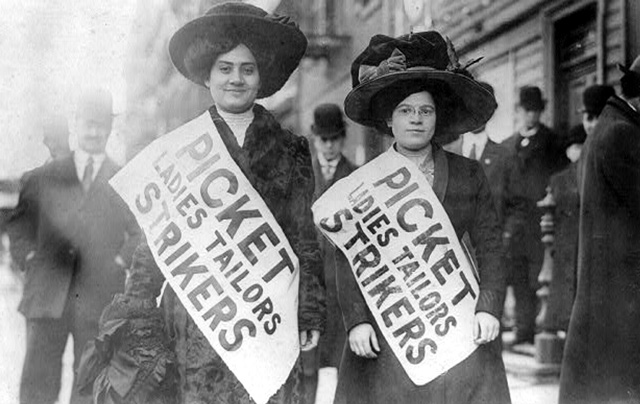The Fight for Wage Equality

Women sewing at long tables next to tall windows in a garment factory. (Kheel Center)
By Tiara Brownie
On March 8, 1857, women in textile factories across New York City staged protests over poor working conditions. It marked one of the first moments women organized to improve their lot on the job. It was also the beginning of what we now know as Women’s History Month. Over 160 years later, women have made great strides in the workplace but the fight for equal pay remains.
Some female-dominated careers such as teaching continue to pay much less than male-dominated careers like that of a construction worker, which require less education. The average construction worker salary in New York is $46,777, but the salary range typically falls between $41,567 and $51,938. While the average entry level teacher salary in New York is $45,618 as of March 28, 2023, but the range typically falls between $38,094 and $55,630. According to the salary website, for teachers and construction workers, the pay rate difference is that of $3,692.
The United States Census Bureau reports that despite teachers’ high levels of education, their average salary is significantly lower than that of other professionals with advanced degrees and has been falling since 2010. To become a construction worker, most construction jobs demand that workers have at least a high school diploma. While they are still in high school, they can take lessons in welding, woodworking, and math to improve their skills. There’s no need for college schooling because companies train these people on the job. But they still make more money than teachers, who must get a bachelor’s degree and a master’s degree in their field in order to teach.
More than 95 percent of K-12 educators have earned a bachelor’s degree or higher. Full-time, year-round primary and middle school teachers with a bachelor’s degree or higher earned a median annual salary of $53,800 in 2019. The median salary for secondary school educators was $57,840.

Strike by lady tailors in New York, February 1910. (Library of Congress)
Aaliyah Rivera is a paraprofessional who has been working with students with disabilities, primarily students who have autism, for almost three years. She was recently honored with a Teacher of the Month certificate for always going above and beyond for her students. She explains how being an educator can be challenging but believes it’s rewarding. “Working as a para is a challenge within itself, but I love what I do,” she said, adding it was an honor to be recognized for her hard work during Women’s History Month. “It’s an amazing feeling.”
River said she loves her job, the students, and the staff, but would appreciate a raise. “I feel like teachers are underpaid. We do so much to get paid so little.” According to career site Zippa, more than 58,605 paraprofessionals are employed in the United States in 2023. Women make up 75.3% of all paraprofessionals, compared to men’s 24.7%. Yet, women made 93% of what men did in 2021.
Work done by women has historically been valued less even when they are doing the same work as men. However there has been federal protections put in place to change this. The Equal Pay Act of 1963 provided protections against sex-based wage discrimination. In 2009, Congress passed Lilly Ledbetter Fair Pay Act, which increases worker wage discrimination protections. Both laws have made it mandatory that employers pay women and men the same compensation when they are performing jobs that are equivalent, or substantially equal, in substance. Pay discrimination victims can seek compensation under federal anti-discrimination laws.
Likewise, the efforts to celebrate women’s role in U.S. history have grown over the years. In 1981, Congress formally established the second week of March as National Women’s History Week. In 1987, Congress extended the celebration to the entire month of March. Ever since then, Congress annually approves a resolution (and the president issues a proclamation) designating the month of March as Women’s History Month. The theme for 2023 is “”Celebrating Women Who Tell Our Stories.”
